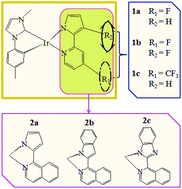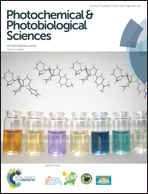A theoretical study on the injection, transport, absorption and phosphorescence properties of heteroleptic iridium(iii) complexes with different ancillary ligands†
Abstract
We have reported a theoretical analysis of a series of heteroleptic iridium(III) complexes (mpmi)2Ir(fppi) [mpmi = 1-(4-tolyl)-3-methyl-imidazole, fppi = 4-fluoro-2-(pyrrol-2-yl)-pyridine] (1a), (mpmi)2Ir(dfpi) [dfpi = 4-fluoro-2-(3-fluoro-pyrrol-2-yl)-pyridine] (1b), (mpmi)2Ir(tfpi) [tfpi = 2-(pyrrol-2-yl)-4-trifluoromethyl-pyridine] (1c), (mpmi)2Ir(priq) [priq = 1-(pyrrol-2-yl)isoquinoline] (2a), (mpmi)2Ir(isql) [isql = 1-(indol-2-yl)-isoquinoline] (2b), and (mpmi)2Ir(biql) [biql = 1-(benzoimidazol-2-yl)-isoquinoline] (2c) by using the density functional theory (DFT) method to investigate their electronic structures, photophysical properties, and the phosphorescent efficiency mechanism. The results reveal that the nature of the ancillary ligands can affect the electron density distributions and energies of frontier molecular orbitals, resulting in changes of charge transfer performances and emission color. It is found that the studied complex 1c with the –CF3 substituent at the pyridine moiety results in the lower HOMO–LUMO energy gap and LUMO energy level, which will lead to a rich electron injection ability compared with that of 1a. For each complex studied (except 2b), the hole-transporting performance is better than the electron-transporting performance. In addition, for complexes 2a and 2b, the differences between reorganization energies for hole transport (λih) and reorganization energies for electron transport (λie) are relatively smaller, indicating that the hole and electron transfer balance could be achieved more easily in the emitting layer. It is believed that the largest metal to ligand charge transfer (MLCT) character, the higher μS1 and ET1 values, as well as the smallest ΔES1–T1 value could result in higher phosphorescent quantum efficiency for 1b than those of other complexes.


 Please wait while we load your content...
Please wait while we load your content...